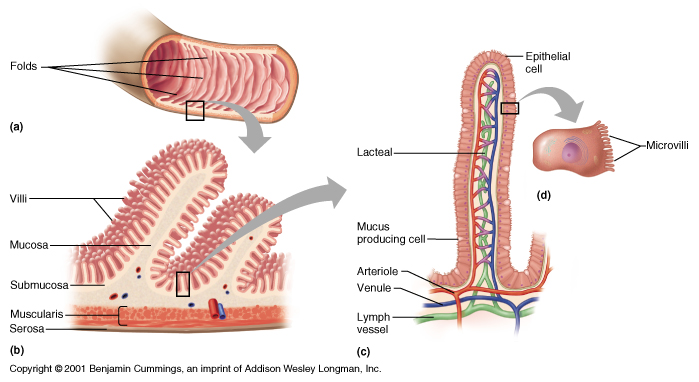How Do Villi Increase the Surface Area
Large surface area provides more surface area for exchange to take place Thin wall reduces the distance that materials need to move Moist assists the transport of materials across the exchange surface The process that the nutrients move into the villi is diffusion. The villi contribute to increase the absorption surface of the nutrients that are ingested and help to lead them into the bloodstream so that they reach each organ according to their function and needs.
Alveolus structure and gas exchange in the lungs nephron structure and water retention in the kidneys villus structure and nutrient absorption in the small intestine and root-hair structure and nutrient absorption in plants are all biological examples in which surface area plays a key role in living things.
. The villi in the small intestine provide a large surface area with an extensive network of blood capillaries. Calculate your new surface area 6. Villi are folds of intestinal skin hence they will greatly increase the surface area compared to a plain surface without folds.
The leaves of plants in general are going to be broad so wide leaves with that are very thin so theyre gonna be flat. They increase the surface area of the intestines to allow digested food to be efficiently absorbed into the bloodstream and. Villus are small finger-like projections that extend into the lumen of the small intestineVilli increase the internal surface area of the intestinal walls making available a greater surface area for absorption.
What finger like projections which. Chorionic villi make up a significant portion of the placenta and serve primarily to increase the surface area by which products from the maternal blood are made available to the fetus. Assuming that one side of each of the two-part ticket has a surface area of approximately 25.
Villi are for absorption hence they will greatly increase the absorption from the intestine to different parts of the body. They have several important features. Modeling the Inside Surface of the Small Intestine 1.
In this regard what are villi. If you stretch the ribbon out and lay it flat in. The function of the plicae circulares the villi and the microvilli is to increase the amount of surface area available for the absorption of nutrients.
The picture above is a diagram of what is inside. The small intestine is divided into the duodenum jejunum and ileum. The presence of villi and micro-villi gives a brush border appearance.
The outer epithelial layer of the chorionic villi is made up of multinucleated syncytiotrophoblast cells which are produced from the fusion of supporting. Villi are specialized for. One may also ask are villi in the duodenum.
Form a cylinder with the 12-ticket strip. And the purpose of this is to increase surface area for light absorption. 10 from Chapter 21 is looking at maximization of surface area and specifically how plants maximize surface area in the leaves and their roots.
Villi increase the surface area of the small intestine dramatically allows for greater absorption of nutrients. Villi also possess blood vessels and lacteals lymphatic vessels. They line the inner surface of the small intestine.
The folded villi greatly increase the surface area of the intestine 2. Click to see full answer. So lets start with leaves.
One way to visualize how villi increase surface area is to compare your intestinal lining to a piece of ribbon. Join the ends of the strip with a small piece of tape. Villi are richly supplied with blood capillaries.
How Do Villi Increase Surface Area. Are found in the small intestine of the digestive system. The correct answer is A.
The villi in the placenta are known as chorionic villi. The villi one is called a villus are tiny finger-shaped structures that increase the surface area. As they typically occupy a thin wall one cell thick which makes a shorter diffusion path Villi are specialised for absorption in the small intestine.
Each villus transports nutrients to a network of capillaries and fine lymphatic vessels called lacteals close to its surface. Their role is to increase the surface area within the small intestine. Villi present in the small intestine increase the absorption rate by increasing the surface area for absorption.
They increase the surface area of small intestine by providing more area for efficient absorption of nutrients. Beside this what makes villi suited for their function. This will lead to the increase of the surface area of absorption as it is the main function of the small intestine.
The folds in the lining of our stomachs or the tiny cellular finger-like projections that protrude from the wall of the intestine villi all act to increase the surface area without increasing the overall size or volume of the organ. Increased surface area for absorption. Put the clay back into the small white tray Part 2.
Villi are small finger-like projections present in the inner lining of the small intestine. They adequately provide a wide surface area so the nutrient absorption of fatty acids and glycerol into the. Villi are tiny finger-like projections from the wall of the small intestine.
Villi are adapted for the maximum absorption of digested food molecules because.
How Do Villi Increase The Surface Area Sarthaks Econnect Largest Online Education Community
Surface Area To Volume Ratio Fried Biochem Knowledge Sauce With A Sprinkle Of Imagination

Why Does The Wall Of The Small Intestine Need A Large Surface Area Socratic

0 Response to "How Do Villi Increase the Surface Area"
Post a Comment